Ingersoll-Rand VL2-030, VL2-005, VL2-010, VL2-015, VL2-150 User Manual
...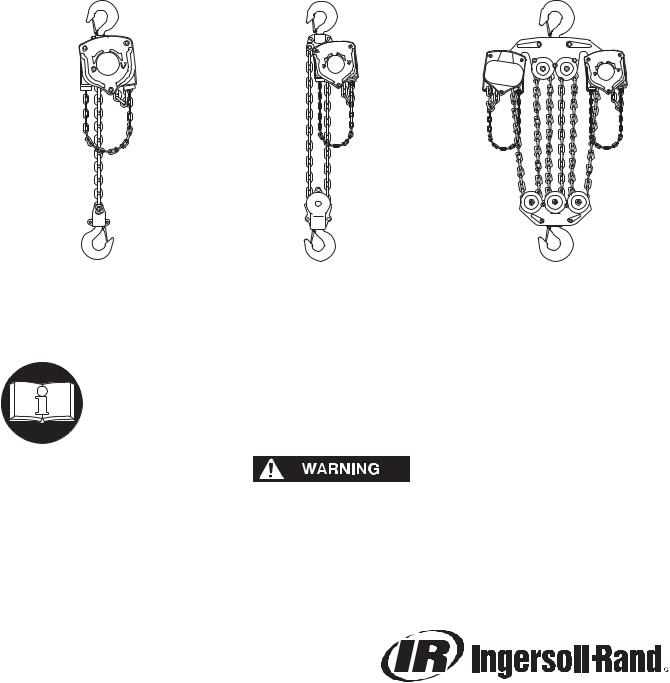
Form MHD56012
PARTS, OPERATION AND MAINTENANCE MANUAL for
MANUAL CHAIN HOIST MODELS
VL2-005 |
VL2-010 |
VL2-015 |
VL2-020 |
VL2-030 |
1/2 ton |
1 ton |
1-1/2 ton |
2 ton |
3 ton |
VL2-050 |
VL2-080 |
VL2-100 |
VL2-150 |
VL2-200 |
5 ton |
8 ton |
10 ton |
15 ton |
20 ton |
Including S•COR•E (Spark and Corrosion Resistant) Features
Unless otherwise noted, tons in this manual are metric tons (2,200 lbs.)
(Dwg. MHP0037) |
(Dwg. MHP0038) |
(Dwg. MHP0039) |
1/2, 1, 1-1/2 and 2 ton |
3 and 5 ton |
15 ton |
READ THIS MANUAL BEFORE USING THESE PRODUCTS. This manual contains important safety, installation, operation and maintenance information. Make this manual available to all persons responsible for the installation, operation and maintenance of these products.
Do not use this hoist for lifting, supporting, or transporting people or lifting or supporting loads over people.
Always operate, inspect and maintain this hoist in accordance with American National Standards Institute Safety Code (ASME B30.16) and any other applicable safety codes and regulations.
Form MHD56012 Edition 8
July 2004 71116107
© 2004 Ingersoll-Rand Company

SAFETY INFORMATION
This manual provides important information for all personnel involved with the safe installation, operation and proper maintenance of this product. Even if you feel you are familiar with this or similar equipment, you should read this manual before operating the product.
Danger, Warning, Caution and Notice
Throughout this manual there are steps and procedures which, if not followed, may result in a hazard. The following signal words are used to identify the level of potential hazard.
Indicates an imminently hazardous situation which, if not avoided, will result in death or serious injury.
Indicates a potentially hazardous situation which, if not avoided, could result in death or serious injury.
Indicates a potentially hazardous situation which, if not avoided, may result in minor or moderate injury or property damage.
Indicates information or a company policy that relates directly or indirectly to the safety of personnel or protection of property.
Safety Summary
•Do not use this hoist for lifting, supporting, or transporting people or lifting or supporting loads over people.
•Hoists are designed to provide a 4 to 1 safety factor. Supporting structures and load-attaching devices used in conjunction with this hoist must provide an adequate safety factor to handle the rated load, plus the weight of the hoist and attached equipment. This is the customer’s responsibility. If in doubt, consult a registered structural engineer.
Ingersoll-Rand hoists are manufactured in accordance with the latest ASME B30.16 standards.
The National Safety Council, Accident Prevention Manual for Industrial Operations, Eighth Edition and other recognized safety sources make a common point: Employees who work near cranes or assist in hooking on or arranging a load should be instructed to keep out from under the load. From a safety standpoint, one factor is paramount: conduct all lifting operations in such a manner that if there were an equipment failure, no personnel would be injured. This means keep out from under a raised load and keep out of the line of force of any load.
The Occupational Safety and Health Act of 1970 generally places the burden of compliance with the user, not the manufacturer. Many OSHA requirements are not concerned or connected with the manufactured product but are, rather, connected with the final installation. It is the owner’s and user’s responsibility to determine the suitability of a product for any particular use. It is recommended that all applicable industry, trade association, federal, state and local regulations be checked. Read all operating instructions and warnings before operation.
Rigging: It is the responsibility of the operator to exercise caution, use common sense and be familiar with proper rigging techniques. Refer to ASME B30.9 for rigging information, American Society of Mechanical Engineers, Three Park Avenue, New York, NY 10016.
2 |
MHD56012 - Edition 8 |
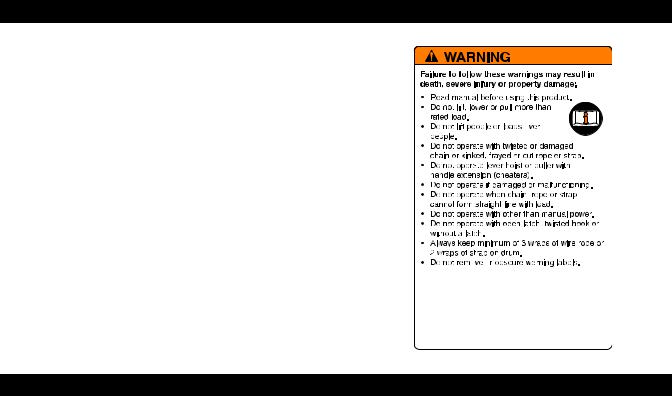
WARNING TAG
Each hoist is supplied from the factory with the warning tag shown. If tag is not attached to your unit, order a new tag and install it. Refer to the parts list for the part number. Read and obey all warnings and other safety information attached to this hoist. Tag may be shown smaller than actual size.
SAFE OPERATING INSTRUCTIONS
The following warnings and operating instructions have been adapted in part from American National Standard ASME B30.16 and are intended to avoid unsafe operating practices which might lead to injury or property damage.
Ingersoll-Rand recognizes that most companies who use hoists have a safety program in force in their plants. In the event that some conflict exists between a rule set forth in this publication and a similar rule already set by an individual company, the more stringent of the two should take precedence.
Safe Operating Instructions are provided to make an operator aware of dangerous practices to avoid and are not necessarily limited to the following list. Refer to specific sections in the manual for additional safety information.
1.Only allow personnel trained in safety and operation to operate hoist.
2.Only operate a hoist if you are physically fit to do so.
3.When a “DO NOT OPERATE” sign is placed on hoist, do not operate hoist until sign has been removed by designated personnel.
4.Before each shift, the operator should inspect hoist for wear or damage.
5.Never use a hoist which inspection indicates is worn or damaged.
6.Periodically, inspect hoist thoroughly and replace worn or damaged parts. Refer to “INSPECTION” section.
7.Lubricate hoist regularly. Refer to “LUBRICATION” section.
8.Do not use hoist if hook latch has been sprung or broken.
9.Check that hook latches are engaged before using.
10.Never splice a hoist chain by inserting a bolt between links.
11.Only lift loads less than or equal to rated capacity of hoist. Refer to “SPECIFICATIONS” section.
12.Never use the hoist chain as a sling.
13.Never operate a hoist when load is not centered under top hook. Do not “side pull” or “yard.”
14.Never operate a hoist with twisted, kinked, “capsized” or damaged load chain.
15.Do not force a chain or hook into place by hammering.
16.Never insert point of hook into a chain link.
17.Be certain load is properly seated in saddle of hook, and hook latch is engaged.
18.Do not support load on tip of hook.
19.Never run load chain over a sharp edge. Use a sheave.
20.When using two hoists to suspend one load, select two hoists each having a rated capacity equal to or more than the load. This provides adequate safety in the event of a sudden load shift.
21.Pay attention to the load at all times when operating hoist.
22.Always ensure that you, and all other people, are clear of load path. Do not lift a load over people.
23.Never use hoist for lifting or lowering people, and never allow anyone to stand on a suspended load.
24.Ease slack out of chain and sling when starting a lift. Do not jerk load.
25.Do not swing a suspended load.
26.Do not leave a load suspended when hoist is unattended or not in use.
27.Never weld or cut a load suspended by the hoist.
28.Never use hoist chain as a welding electrode.
29.Do not operate hoist if chain jumping, excessive noise, jamming, overloading or binding occurs.
30.Keep load from hitting load chain.
31.Only operate the hoist with manual power.
32.After use, or when in a non-operational mode, hoist should be secured against unauthorized and unwarranted use.
MHD56012 - Edition 8 |
3 |
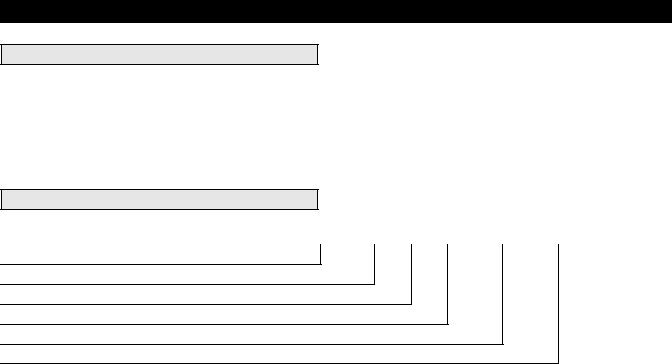
SPECIFICATIONS
General
The VL2 Manual Chain Hoist can be mounted to the suspension shaft of a trolley or a permanent mounting structure. The hoist is designed to lift and lower loads up to rated capacity with minimal effort.
To determine your hoist configuration refer to the capacity and serial number nameplate for serial and model number information.
Model Code Explanation
Model Code Example: |
VL2-050-10-8V |
VL2 - 050 |
- |
10 - 8 |
V |
Series
Hoist Capacity
S•COR•E
Lift
Hand Chain Drop
Options
|
|
|
|
Hoist |
|
|
|
|
|
|
Lift: |
|
|
|
Hand Chain Drop: |
|
|
|
|
|||
Series |
|
|
|
|
S•COR•E |
|
|
(Hoist load chain/hook |
|
(Hand chain is 2 ft. (0.6 m) |
|
Options |
|
|||||||||
|
|
Capacity |
|
|
|
|
|
|
||||||||||||||
|
|
|
|
|
|
|
|
|
travel) |
|
|
|
|
less than lift) |
|
|
|
|
|
|||
|
|
|
|
|
|
|
|
|
|
|
|
|
|
|
|
|
|
|
|
|||
|
|
|
|
|
|
|
|
|
|
|
|
|
|
|
|
|
|
|
||||
VL2 |
= 005, 010, |
- = Standard |
|
|
10 |
= Hook travel, 10 |
|
8 |
= Lift 10 ft. chain drop |
V |
= Overload Clutch |
|||||||||||
|
|
015, 020, |
CP = Copper Plated |
|
std, 15 and 20 ft. |
|
|
8 ft. (standard) |
|
(standard) |
|
|||||||||||
|
|
030, 050, |
SB = Solid Bronze |
|
XX = Specify length |
|
13 |
= Lift 15 ft. chain drop |
H |
= Zinc Plated hand chain |
||||||||||||
|
|
080, 100, |
|
|
|
|
|
|
|
|
|
|
|
13 ft. |
|
|
S•COR•E |
|
||||
|
|
150 and 200 |
|
|
|
|
|
|
|
|
|
18 |
= Lift 20 ft. chain drop |
N |
= Nickel plated load |
|||||||
|
|
|
|
|
|
|
|
|
|
|
|
|
|
|
|
18 ft. |
|
|
chain S•COR•E |
|||
|
|
|
|
|
|
|
|
|
|
|
|
|
|
XX= Specify drop |
|
Z |
= Sand blast/carbozinc |
|||||
|
|
|
|
|
|
|
|
|
|
|
|
|
|
|
|
|
|
|
P |
= Marine Grade |
|
|
|
|
|
|
|
|
|
|
|
|
|
|
|
|
|
|
|
|
|
|
corrosion preventative |
||
|
|
|
|
|
|
|
|
|
|
|
|
|
|
|
|
|
|
|
|
finish |
|
|
|
|
|
|
|
|
|
|
|
|
|
|
|
|
|
|
|
|
|
S |
= Chain Container |
||
|
|
|
|
|
|
|
|
|
|
|
|
|
|
|
|
|
|
|
|
(fabric) |
|
|
|
|
|
|
|
|
|
|
|
|
|
|
|
|
|
|
|
|
|
-E = Meets European |
|||
|
|
|
|
|
|
|
|
|
|
|
|
|
|
|
|
|
|
|
|
Machinery Directives |
||
|
|
|
|
|
|
|
|
|
|
|
|
|
|
|
|
|
|
|
|
|||
|
|
|
|
|
|
|
|
|
|
|
|
|
|
|
|
|
|
|
||||
|
|
|
|
Rated |
|
Pull to lift rated load |
Load |
Hand Chain O’Hauled |
|
|
|
Hoist Net Weight |
||||||||||
|
|
|
|
Capacity |
|
to lift load 1 ft (0.3 m) |
|
No. of |
|
(std. 10 ft. lift) |
||||||||||||
Model No. |
|
|
|
|
|
|
|
Chain size |
|
|
||||||||||||
|
metric |
|
|
|
|
|
|
|
|
|
|
|
|
chain falls |
|
|
|
|||||
|
|
|
|
|
lb |
|
|
kg |
(mm) |
|
ft |
|
m |
|
lb |
|
kg |
|||||
|
|
|
|
tons* |
|
|
|
|
|
|
|
|
|
|||||||||
|
|
|
|
|
|
|
|
|
|
|
|
|
|
|||||||||
VL2-005 |
|
|
1/2 |
|
55 |
|
|
25.0 |
5.0 x 15 |
|
25 |
|
7.6 |
|
|
|
20 |
|
9.0 |
|||
VL2-010 |
|
|
1 |
|
73 |
|
|
33.2 |
6.3 x 19.2 |
|
28 |
|
8.5 |
|
1 |
|
36 |
|
16.4 |
|||
VL2-015 |
|
|
1-1/2 |
|
74 |
|
|
33.6 |
7.1 x 21.2 |
|
57 |
|
17.4 |
|
|
45 |
|
20.4 |
||||
|
|
|
|
|
|
|
|
|
|
|
||||||||||||
VL2-020 |
|
|
2 |
|
76 |
|
|
34.5 |
8.0 x 24.2 |
|
73 |
|
22.3 |
|
|
|
50 |
|
22.7 |
|||
VL2-030 |
|
|
3 |
|
|
|
7.1 x 21.2 |
|
112 |
|
34.1 |
|
2 |
|
52 |
|
23.6 |
|||||
|
|
|
|
|
|
|
|
|
|
|
|
|
||||||||||
VL2-050 |
|
|
5 |
|
85 |
|
|
38.6 |
|
|
181 |
|
55.2 |
|
|
94 |
|
42.6 |
||||
|
|
|
|
|
|
|
|
|
|
|
|
|||||||||||
VL2-080 |
|
|
8 |
|
90 |
|
|
40.9 |
|
|
272 |
|
82.9 |
|
3 |
|
150 |
|
68.2 |
|||
VL2-100 |
|
|
10 |
|
|
|
9.0 x 27.2 |
|
362 |
|
110.3 |
|
4 |
|
188 |
|
85.5 |
|||||
|
|
|
|
|
|
|
|
|
|
|
|
|
||||||||||
VL2-150 |
|
|
15 |
|
2 x 90 |
|
2 x 41 |
|
2 x 272 |
|
2 x 82.9 |
|
6 |
|
395 |
|
179.5 |
|||||
VL2-200 |
|
|
20 |
|
|
|
2 x 362 |
|
2 x 110 |
|
8 |
|
485 |
|
220.4 |
|||||||
|
|
|
|
|
|
|
|
|
|
|
|
|
||||||||||
|
|
|
|
|
|
|
|
|
|
|
|
|
|
|
|
|
|
|
|
|
|
|
* One metric ton equals 2200 lbs.
4 |
MHD56012 - Edition 8 |
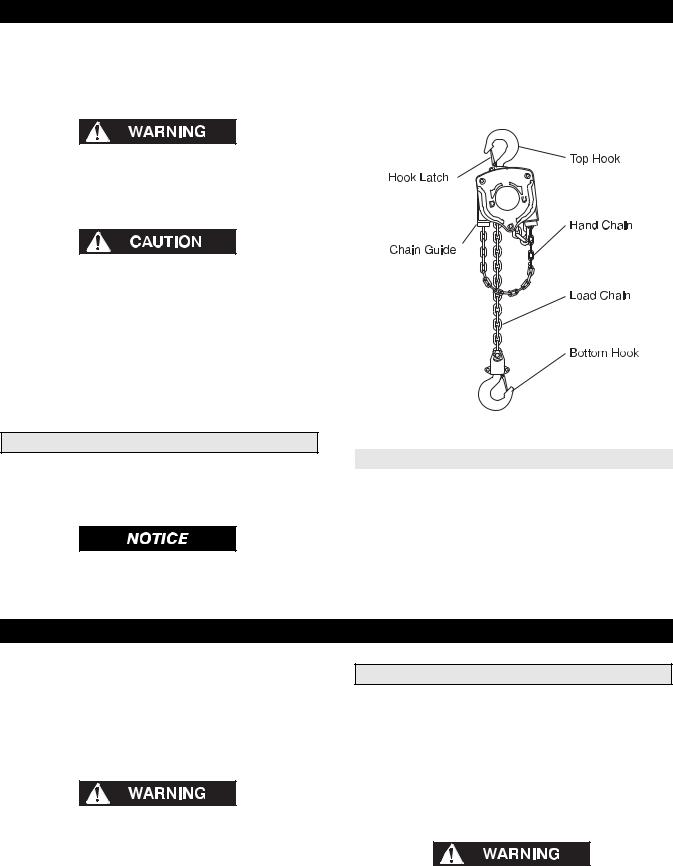
INSTALLATION
Prior to installing hoist, carefully inspect it for possible shipping damage. Hoists are supplied fully lubricated from the factory. Lubrication of the load chain is recommended before initial hoist operation.
•Depending on model selected, hoist may weigh up to 485 lbs. (220 kg). If parts of the hoist are dropped, they can cause injury, death or property damage. Adequately support hoist during installation.
•Owners and users are advised to examine specific, local or other regulations, including ASME standards and/or OSHA Regulations which may apply to a particular type of use of this product before installing or putting hoist to use.
The VL2 manual chain hoist must be used in a vertical position to provide a straight line pull from top to bottom hook. The hoist must be positioned so that it does not contact the support members when in use. When operating in limited areas suitable lifting attachments or slings must be used to prevent hoist body and hand chain from being obstructed.
Initial Operating Checks
Operate hoist with a test load (10% of rated capacity) by raising and lowering this load several times. Verify brake operation with this light load prior to applying heavier loads.
• Each time a load is lifted, the operation of the brake should be checked by raising load slightly and stopping to ensure brake will hold load before continuing to lift.
Familiarize operators and personnel responsible for hoist installation and service with ASME B30.16 specifications and this manual prior to placing unit into service. All requirements of this specification, including testing should be met before approving hoist for operation.
(Dwg. MHP0436)
Installing Chain Container
Refer to Dwg. MHP0321 on page 19. Position chain container to ensure minimum contact with handchain. On larger CC-8 and CC- 9 style chain containers which use S-Hooks to support chain container, ensure hook ends are bent closed.
OPERATION
The four most important aspects of hoist operation are:
1.Follow all safety instructions when operating hoist.
2.Allow only personnel trained in safety and operation of this hoist to operate hoist.
3.Subject each hoist to a regular inspection and maintenance procedure.
4.Be aware of the hoist capacity and weight of load at all times.
• Hoist is not designed or suitable for lifting, lowering or moving persons. Never lift loads over people.
Hoist Operation
When facing hand chain side of hoist:
Pull down on right hand chain (clockwise) to raise load.
Pull down on left hand chain (counterclockwise) to lower load.
On 15 and 20 ton hoists, use two operators, one on each of the two hand chains. To keep the load chain centered in the block assemblies, operate hoist units simultaneously and at the same speed. An equal amount of unloaded chain must be maintained under each hoist body.
• Do not allow load chain, on 15 and 20 ton hoists, to accumulate on one side (under one hoist body). Excessive loading to load chain anchor may occur resulting in a falling load which can cause death, injury or property damage.
MHD56012 - Edition 8 |
5 |

• The clicking sound of the pawl on the ratchet gear is normal when a load is being raised.
Storing the Hoist
1.Always store hoist in a no load condition.
2.Wipe off all dirt and water.
3.Oil the chain, hook pins and hook latch pins.
4.Hang in a dry place.
5.Before returning hoist to service follow instructions for Hoists not in Regular Service in “INSPECTION” section.
INSPECTION
• All new, altered or modified equipment should be inspected and tested by personnel trained in safety, operation and maintenance of this equipment to ensure safe operation at rated specifications before placing equipment in service.
Frequent and periodic inspections should be performed on equipment in regular service. Frequent inspections are visual examinations performed by operators or service personnel and include observations made during routine equipment operation. Periodic inspections are thorough inspections conducted by personnel trained in the safety, operation and maintenance of this equipment. ASME B30.16 states inspection intervals depend upon the nature of the critical components of the equipment and severity of usage.
Careful inspection on a regular basis will reveal potentially dangerous conditions while still in the early stages, allowing corrective action to be taken before the condition becomes dangerous.
Deficiencies revealed through inspection, or noted during operation, must be reported to designated personnel trained in safety, operation and maintenance of this equipment. A determination as to whether a condition constitutes a safety hazard must be decided, and the correction of noted safety hazards accomplished and documented by written report before placing the equipment in service.
Records and Reports
Inspection records, listing all points requiring periodic inspection should be maintained for all load bearing equipment. Written reports, based on severity of service, should be made on the condition of critical parts as a method of documenting periodic inspections. These reports should be dated, signed by the person who performed the inspection, and kept on file where they are readily available for review.
Load Chain Reports
Records should be maintained documenting the condition of load chain removed from service as part of a long-range load chain inspection program. Accurate records will establish a relationship between visual observations noted during frequent inspections and the actual condition of the load chain as determined by periodic inspection methods.
Frequent Inspection
The Manual Chain Hoist should be inspected at the beginning of each shift. Visual inspections should also be conducted during regular service for any damage or evidence of malfunction which appears between regular inspections.
1.OPERATION. Check for visual signs or abnormal noises which could indicate a potential problem. Do not operate a hoist unless the chain feeds through the hoist and hook block smoothly. Listen for “clicking”, binding or malfunctioning. The clicking sound of the pawl on the ratchet gear is normal when a load is being raised. If chain binds, jumps, or is excessively noisy, clean and lubricate the chain. If problem persists, replace the chain. Do not operate the hoist until all problems have been corrected. Check that hand chain moves freely and without binding or excessive drag. Hook should stop moving when hand chain stops moving.
2.HOOKS. Check for wear or damage, increased throat width, bent shank or twisting of hook. Replace hooks that exceed the throat opening discard width (15%) shown in Table 1 refer to Dwg. MHP0040 on page 6, or exceed a 10º twist refer to Dwg. MHP0111 on page 7. If hook latch snaps past tip of hook, hook is sprung and must be replaced. Check hook support bearings for lubrication and damage. Check hooks swivel easily and smoothly. Repair or lubricate as necessary.
• The external placement of coded marks on equipment
identifying completed inspections and operationally certified (Dwg. MHP0040) equipment is an acceptable method of documenting periodic
inspections in place of written records.
6 |
MHD56012 - Edition 8 |
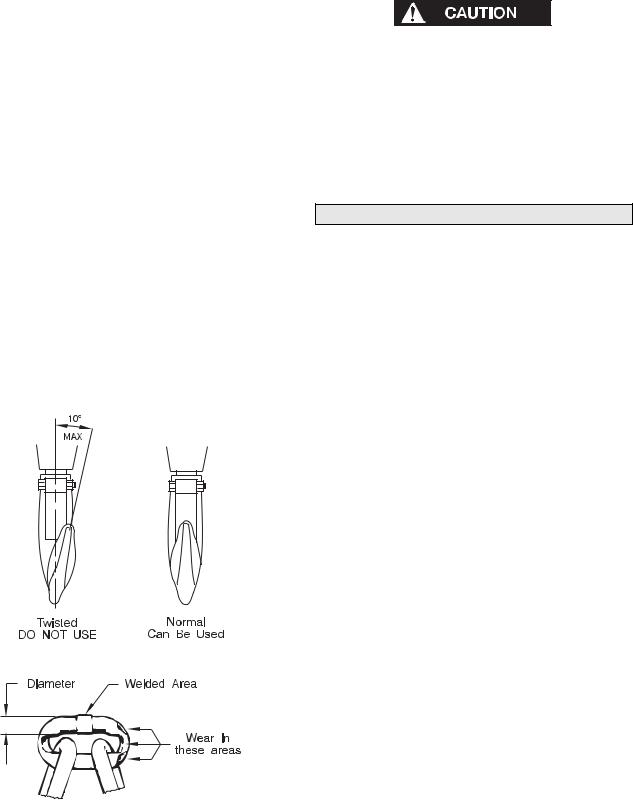
Table 1: Hook Throat Dimension
Model No. |
Throat Width |
Discard Width |
|||
|
|
|
|
||
in. |
mm |
in. |
mm |
||
|
|||||
VL2-005 |
1.22 |
31 |
1.4 |
35.6 |
|
VL2-010 |
1.33 |
34 |
1.54 |
39.1 |
|
VL2-015 |
1.5 |
38 |
1.72 |
43.7 |
|
VL2-020 |
1.61 |
41 |
1.86 |
47.2 |
|
VL2-030 |
1.85 |
47 |
2.12 |
54 |
|
VL2-050 |
2.01 |
51 |
2.31 |
58.6 |
|
VL2-080 |
2.8 |
71 |
3.21 |
81.6 |
|
|
|||||
VL2-100 |
|||||
|
|
|
|
||
VL2-150 |
3.54 |
90 |
4.07 |
103.5 |
|
|
|||||
VL2-200 |
|||||
|
|
|
|
||
|
|
|
|
|
|
3.HOOK LATCHES. Check operation of hook latches. Replace if broken or missing.
4.CHAIN. Refer to Dwg. MHP0102 on page 7. Examine each link for bending, cracks in weld areas or shoulders, transverse nicks and gouges, weld splatter, corrosion pits, striation (minute parallel lines) and chain wear, including bearing surfaces between chain links. Replace a chain that fails any of the inspections. Check lubrication and lubricate if necessary. Refer to “Load Chain” in “LUBRICATION” section.
(Dwg. MHP0111)
(Dwg. MHP0102)
•The full extent of chain wear cannot be determined by visual inspection. At any indication of chain wear inspect chain and load sheave in accordance with instructions in “Periodic Inspection.”
•A worn load chain may cause damage to load sheave. Inspect load sheave and replace if damaged or worn.
5.LOAD CHAIN REEVING. Refer to Dwg. MHP0042 on page 9. Make sure welds on standing links are away from load sheave. Reinstall chain if necessary. Make sure chain is not capsized, twisted or kinked. Adjust as required.
Periodic Inspection
According to ASME B30.16, frequency of periodic inspection depends on the severity of usage:
NORMAL |
HEAVY |
SEVERE |
yearly |
semiannually |
quarterly |
Disassembly may be required for HEAVY or SEVERE usage. Keep accumulative records of periodic inspections to provide a basis for continuing evaluation. Inspect all items in “Frequent Inspection.” Also inspect the following:
1.FASTENERS. Check rivets, capscrews, nuts, cotter pins and other fasteners on hooks, hoist body and chain bucket, if used. Replace if missing and tighten or secure if loose.
2.ALL COMPONENTS. Inspect for wear, damage, distortion, deformation and cleanliness. If external evidence indicates the need, disassemble. Check gears, shafts, bearings, sheaves, chain guides, springs and covers. Replace worn or damaged parts. Clean, lubricate and reassemble.
3.HOOKS. Inspect hooks for cracks. Use magnetic particle or dye penetrant to check for cracks. Inspect hook retaining parts. Tighten, repair or replace if necessary. Refer to the latest edition of ASME B30.10 (Hooks) for additional hook inspection information.
4.CHAIN SHEAVES. Check for excessive wear or damage. Replace if necessary.
5.BRAKES. Ensure proper operation. Brake must hold hoist rated capacity. If load test indicates the need, disassemble. Brake discs must be free of excess oil, any grease, unglazed, uniform in thickness and at least 5/64 in. (2 mm) thick. Check all other brake surfaces for wear, deformation or foreign deposits. Inspect pawl brake. Teeth of ratchet gear should be undamaged, and should stop gear rotation in the counterclockwise direction. Check pawl spring for damage. Clean and replace components as necessary.
6.SUPPORTING STRUCTURE. If a permanent structure is used, inspect for continued ability to support load.
7.LABELS AND TAGS. Check for presence and legibility. Replace if necessary.
8.END ANCHOR. Ensure end anchor on chain hoist is engaged and unbent. Repair if damaged, replace if missing. Refer to “Attaching End of Load Chain” in “MAINTENANCE” section.
9.LOAD CHAIN. Measure chain for stretching by measuring across five link sections all along chain. Refer to Dwg. MHP0041on page 8 and Table 2. When any five links in the working length reach or exceed discard length shown in Table 2, replace entire chain. Always use a genuine Ingersoll-Rand replacement chain.
MHD56012 - Edition 8 |
7 |
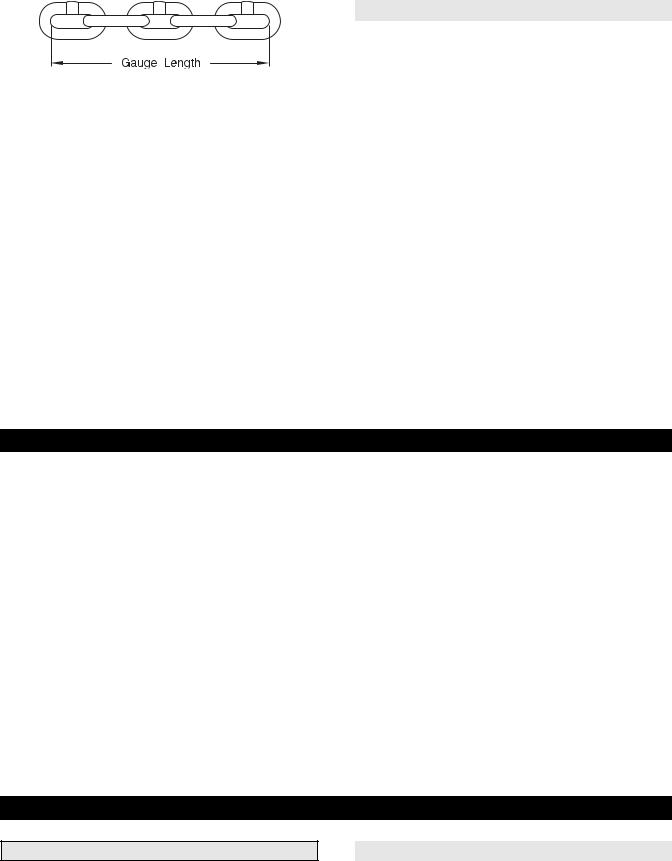
(Dwg. MHP0041)
Table 2: Load Chain Length Inspection
Model |
|
Chain |
Normal |
Discard |
||
Part No. |
Size |
Length |
Length |
|||
No. |
|
|
|
|
|
|
|
mm |
in. |
mm |
in. |
mm |
|
|
|
|||||
VL2-005 |
LCCF005 |
5.0 x 15 |
2.95 |
75.0 |
3.03 |
77.0 |
VL2-010 |
LCCF010 |
6.3 x 19.2 |
3.76 |
95.5 |
3.85 |
97.9 |
VL2-015 |
LCCF015 |
7.1 x 21.2 |
4.17 |
106.0 |
4.28 |
108.7 |
VL2-020 |
LCCV020 |
8.0 x 24.2 |
4.72 |
120.0 |
4.84 |
123.0 |
VL2-030 |
LCCF015 |
7.1 x 21.2 |
4.17 |
106.0 |
4.28 |
108.7 |
VL2-050 |
|
|
|
|
|
|
|
|
|
|
|
|
|
VL2-080 |
|
|
|
|
|
|
|
|
|
|
|
|
|
VL2-100 |
LCCF025 |
9.0 x 27.2 |
5.35 |
136.0 |
5.47 |
139.0 |
|
|
|
|
|
|
|
VL2-150 |
|
|
|
|
|
|
|
|
|
|
|
|
|
VL2-200 |
|
|
|
|
|
|
|
|
|
|
|
|
|
Note: Nickel Plated load chain for the VL2 is designated by “ND” at the end of the part number.
Hoists not in Regular Service
1.A hoist that has been idle for a period of one month or more, but less than one year should be given an inspection conforming with requirements of “Frequent Inspection” before being placed in service.
2.A hoist that has been idle for a period of more than one year should be given a complete inspection conforming with requirements of “Periodic Inspection” before being placed in service.
3.Standby hoists should be inspected at least semiannually in accordance with requirements of “Frequent Inspection.” In abnormal operating conditions equipment should be inspected at shorter intervals.
TROUBLESHOOTING
This section provides basic troubleshooting information. Specific causes to problems are best identified by thorough inspections performed by personnel instructed in safety, operation and maintenance of this equipment. The chart below provides a brief guide to common hoist symptoms, probable causes and remedies.
Symptom |
Cause |
Remedy |
|
|
|
|
|
Hoist will not lift load. |
Hoist is overloaded. |
Reduce load to within hoist rated capacity. |
|
|
|
|
|
Hoist will not hold load. |
Brake may be slipping. |
Inspect brake. Replace brake discs or repair brake as described in |
|
|
|
the “MAINTENANCE” section. |
|
|
|
|
|
|
Hoist is overloaded. |
Reduce load to within hoist rated capacity. |
|
|
|
|
|
Load Chain Binds. |
Damaged load chain, pinion shaft, gears or |
Disassemble hoist, inspect and repair or replace damaged |
|
|
sheaves. |
components. |
|
|
|
|
|
|
Load chain not installed properly (twisted, |
Remove load chain and re-install. |
|
|
kinked or “capsized”). |
|
|
|
|
|
|
Hand Chain Binds. |
Damaged hand chain, hand chain wheel, |
Disassemble hoist, inspect and repair or replace damaged |
|
|
pinion shaft, gears, load chain, sheaves. |
components. |
|
|
|
|
|
|
Hand chain not installed properly (twisted or |
Remove load chain and re-install. |
|
|
kinked). |
|
|
|
|
|
|
Load Hook Latch does |
Latch broken. |
Replace hook latch. |
|
not work. |
|
|
|
Load hook bent or twisted. |
Inspect load hook as described in “INSPECTION” section. |
||
|
|||
|
|
Replace if necessary. |
|
|
|
|
LUBRICATION
General
Thread lubricant or an anti-seize compound use is recommended for threaded shafts, capscrews and nuts. Unless otherwise stated, remove old lubricant, clean part with an acid free solvent and apply a new coating of lubricant to part before assembly.
8
Gears (11 and 14)
Remove U-nuts (40), on opposite side of hoist as the hand chain, and remove gear cover (17) and support plate (16). Remove old grease and replace with new. For temperatures -20° to 50° F (-29° to 10° C) use EP 1 grease or equivalent. For temperatures 30° to 120° F (-1° to 49° C) use EP 2 grease or equivalent.
MHD56012 - Edition 8
